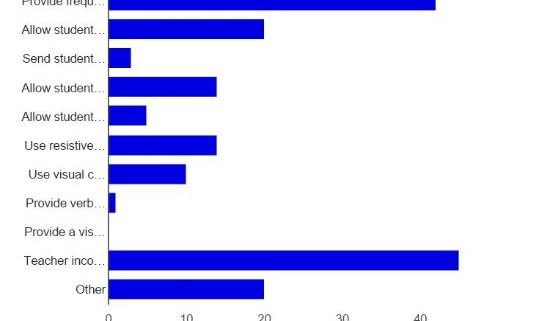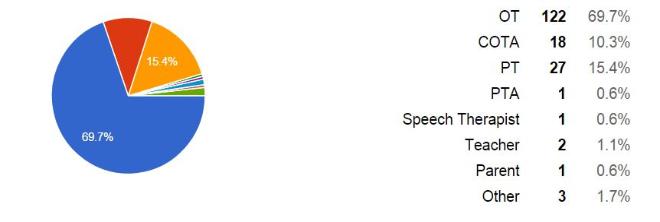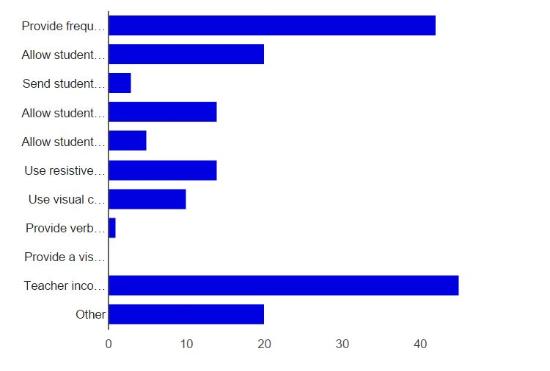
QUESTION #1: Are you a pediatric OT/COTA, PT/PTA, Parent, Teacher or other?

QUESTION #2: When a student has difficulty controlling his/her level of physical activity during a school lesson, what modification/intervention do you find to be the most successful?
- Provide frequent physical activity breaks from seat work: 42 (24.1%)
- Allow student to work standing up: 20 (11.5%)
- Send student on frequent errands to increase physical activity: 3 (1.7%)
- Allow student to sit on a therapy ball: 14 (8%)
- Allow student to sit in a rocking chair: 5 (2.9%)
- Use resistive tubing tied around the chair or desk for student to push against while sitting: 14 (8%)
- Use visual cues (ie polyspot, X taped on the floor, etc) to designate where the student should sit on the floor: 10 (5.7%)
- Provide verbal cues to remain in seat: 1 (0.6%)
- Provide a visual reminder at the desk to remain in the seat during this activity: 0 (0%)
- Teacher incorporates movement into lesson plans: 45 (25.9%)
- Other: 20 (11.5%)

Brain Break Ideas for the Classroom
Comments:
- I have had great success with resistive tubing as well as using move and sit cushions.
- At the school where I work, more and more teachers are incorporating “brain breaks” using movement activities available on YouTube. It’s proven to be a great intervention!
- “The most effective strategies occur when I know what the teacher’s classroom and teaching style is like and match the strategy to that.”
- I also play engine games/song with all the children in the classroom so they can start to monitor their own energy levels and modify their energy to the task.
- All may work for a student depending upon their needs. So one modification may not be the universal answer. Pictorial support with verbal instruction is also needed.
- give a specific time that he is needed to be seated: after writing two sentences than you can stand and stretch.
- Depends on the student’s age and teacher cooperation and flexibility. But usually start with tubing tied around chair or desk.
- You have to individualize to see what works for each student. I probably try all of the above
- Movement fuels the brain.
- I use many more than one strategy
- We give air cushions to sit on.
- My 6 year old son has ADHD and bis school have put alot into place to help him benefit more in his classes. He does a sensory circuit every morning and various activities throughout the day. It really has helped him improve his learning.
- it all depends on the teacher and their ability to change, to accept a student doing something different or to allow movement in their visual field.
- Almost all of these strategies work if the teacher is willing. The best is teacher incorporating movement.
- I work with mostly preschoolers and more supportive seating and/or a weighted lap buddy seem to help the most immediately anyway.
- If desk/seat is appropriate then I will trial all the options listed above and see what type of intervention a teacher is willing to try and can tolerate in their classroom. Or a Disco Sit cushion.
- If they cant sit still their system must NEED movement for one reason or another. These tools allow for movement while still seated at desk with minimal distraction to those around the student. I use a ball chair and not just a loose ball.
- Resistive type activities are great too!
- As long as the student can follow through with directions, attend, and complete work ignore/forgive movement/fidgeting.
- This is so dependent on the child! We have used all of the above and had success with each of them for different kids. Hard to pick what works “best”.
- “Sit on a bumpy cushion Use a lap weight, lap pad
- Sit in a “”stadium seat”” chair on the floor for circle time”
- This is certainly confining to only be able to use one modification/ intervention. One must not only consider the individual student and their needs and what works to manage their physical activity but also the other students in the classroom and their needs. All of the above are viable options but it just
depends upon the class, the student, and the needs of the other students. - I provide lots of the above modifications depending on the student. Allowing movement breaks seems to be the most popular, though.
- Allow chewing gum
- Movement breaks for the Whole Class is important for all students not just the ones with “Extra Energy”. Everyone requires some sorta of movement break even adults at their work place.
- Standing allows more movement and less strain on back.
